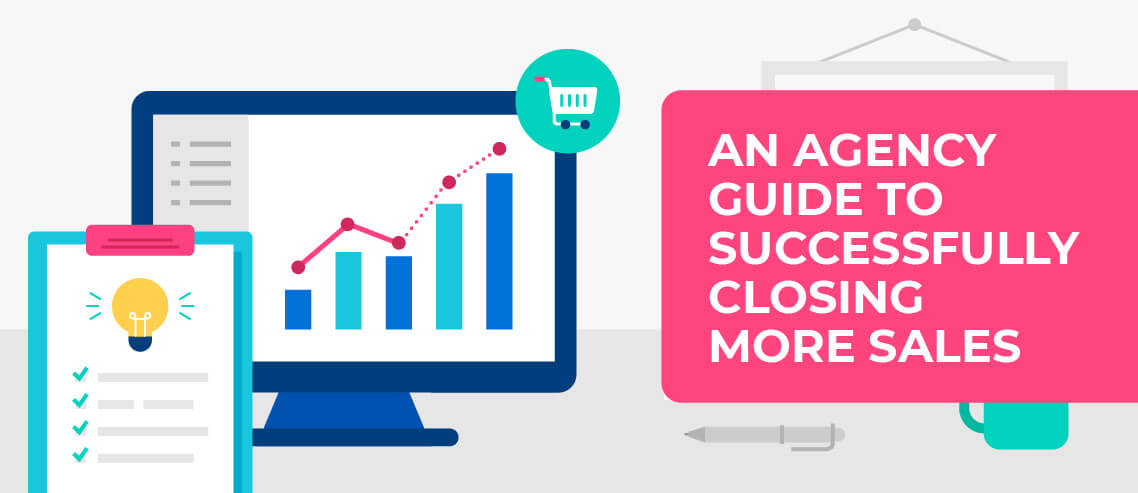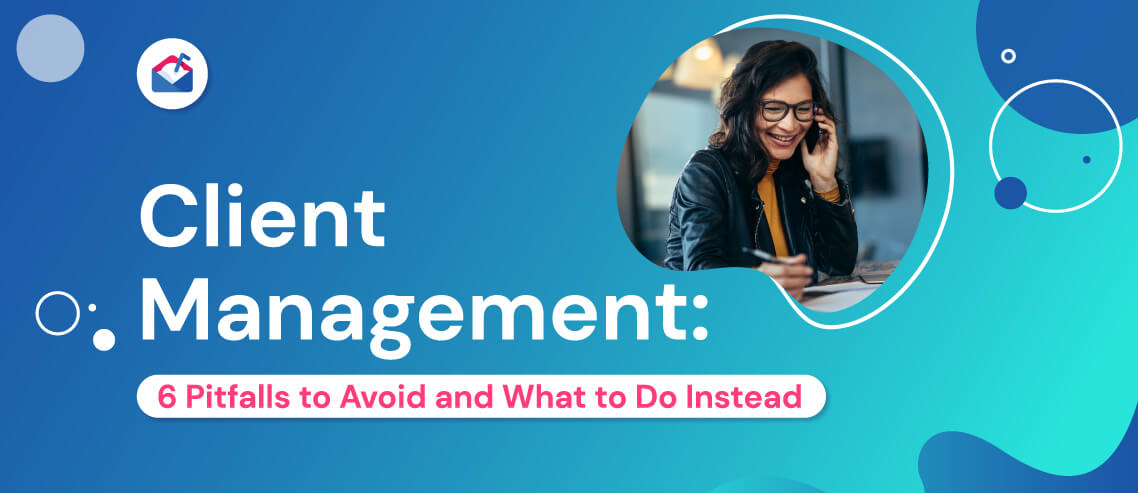An Agency Guide to Successfully Closing More Sales

Contents
Every agency needs new leads. The fact that you’re on this site means you recognize that cold outreach is an important part of your sales strategy. Fundamentally this is a numbers game; the more emails you send the higher the chance you’ll find a person interested in your service.
To improve the response rate you can do things like split test the subject lines, and email copy. Using multivariate testing it’s relatively easy to improve those conversion rates. Learning how to close a sale is not as simple.
Statistics recently published by HubSpot reveals that 74% of companies view converting leads or contacts into customers as their primary marketing priority. It outstrips increasing revenue from existing customers or even trying to boost web traffic.

The figures provide an insight into just how difficult it can be for a company to close a sale — especially when it’s one of the many tasks on your plate (growing traffic, increasing revenue per customer, reducing cost per lead, and more).
In this article, I’ll share some of the strategies that we use to consistently turn prospective clients into leads for the agency I work for. This system has helped us land mid-five figure enterprise clients, a number of banks, some Russell Group Universities, and multinational corporations. It’s a strategy that I’ve also applied successfully to my own freelance work.
How to Prep For Your Sales Meeting
You can’t expect a call to a prospect to go well if you don’t prepare for it. Even the best salespeople can’t turn leads into sales on a regular basis if they’re flying by the seat of their pants. As the old saying goes, failing to prepare really is the same as preparing to fail.
On the other hand the more organized you are the higher the chance you will close the sale. In fact, with a proper plan in place running a meeting can become second nature. The process starts by completing a pre-meeting checklist.
A Guide to Prospect Research
People like to work with companies who are organized, know what they are doing, and understand the pain points that the client is facing. The best way to leave the impression that you are organized and prepared is to spend time researching both the person you will be talking with and the company that you are offering a product or service.
Luckily the internet makes this work pretty easy. Most professionals have a LinkedIn profile. A quick browse of a person’s profile will reveal:
- Their employment history – pay special attention to how long they have been in their current position, and if they are a decision maker. A new employee is often looking to shake things up and leave their mark, which often means finding new agencies to work with.
- Their interests – review their LinkedIn timeline to see the kind of content that they are commenting on.
In addition to looking at their LinkedIn profile, search through other social networks and do a quick Google to see what else you can find out about them. Don’t spend too much time on this – you don’t want to give them the impression that you’re a crazy stalker! Rather you want to gain an understanding of their professional status and identify some shared points of interest.
The kind of things you are looking for include people who you know in common, the university course they studied, sports they are interested in, etc. These are things you can talk about in your meeting.
How to Research a Company Prior to Your Meeting
On top of this, you should research the company you will be dealing with. There are two parts to this process. First, you need to find out if they’re a suitable client. You want to research things like:
- Annual revenue, and company assets
- Total number of employees
- How long have they been around
This will give you a good idea about the company.
LinkedIn is a good resource for finding out information about employee numbers. Another obvious place to search for facts about the size of a company is the About Page on a company website.
If you are dealing with a listed public company, i.e. a company with shareholders, it should be quite easy to determine their assets. In the UK, a quick search of accounts filed with Companies House will provide you with this information. A review of their financial history could indicate things like a year on year decrease in company revenue. This kind of information is useful to have before you enter a sales meeting.
It is harder to access the accounts of a private company. With a bit of intuitive online research, you might find an annual report or some other information that is indicative of a company’s revenue and assets. For example, you can see how a five-minute search on Google quickly revealed some information about how Mailshake is doing.

The other thing you should think about is how long the company has been around.
As a general rule of thumb, the longer a company has been established, and the larger the company, the slower the procurement process. Smaller companies that are still run by their founders tend to make decisions a little faster.
This is something to consider when evaluating the leads you are targeting.
More importantly, spend time researching how you can help the lead. For example, when reviewing a website, I do things like analyze website page speed, how much content has been indexed on Google, conduct competitor analysis, keyword research, and a bunch of other stuff.
All of this research will help you provide clear actionable feedback regarding the benefits you can offer a prospective client. You do not want to come to a meeting underprepared. At best you will be flying by the seat of your pants, at worst you’ll appear incompetent.
Now time for an unusual sales closing tip…
An Unusual But Effective Sales Closing Tip
In a regular sales meeting, the ‘power’ is normally held by the potential client. They are the person signing the cheques and more often than not asking the questions. The best way to address this issue is to set the lead tasks prior to your sales meeting.
With the SEO company I work for we always ask leads to complete two tasks prior to a meeting:
- Answer a short questionnaire regarding their needs and budget
- Provide access to Google Analytics, and Google Search Console
Getting a potential client to complete these tasks is useful for a number of reasons:
- You know what their budget is before a sales meeting
- You will discover their pain points and needs
- Places you in a better position to be the ‘teacher’
There’s a lot of psychology behind this idea of setting tasks that I won’t go into… Fundamentally the important thing, which makes this sales closing tip so effective, is that it helps you identify if the lead is serious about working with you. Furthermore, it helps you provide better insights during the sales meeting.
How to Prepare A Sales Pitch Script
Once all those other tasks are completed you’re in a great position to prepare for your sales call. You want to keep the customer pain points at the forefront of your mind when preparing your pitch. That way you can ensure that your pitch is selling the solutions to your prospect’s real and individual problems.
You want to make sure that your sales pitch is focused on their needs and the outcomes that they are after. It’s a result first kind of strategy. Let me explain…
Businesses don’t like to spend money, they like to make money!
What you are offering, if you are providing a service, is an investment. Below is an example to illustrate my point:
- I will charge you $5,000 a month for SEO. For this money, I’ll design you a super fast high converting website with content focused around the right keywords.
- If you work with me I will make you $20,000 extra every month. It will cost you $5,000 a month for my services.
That second statement is a lot more appealing.
When a company outsources a service they have clear targets. They don’t care about the process, they just want the results. The Return on Investment (ROI) to use business speak. Your pitch should be results focused.
You need to prove your expertise and show where you add value.
The nice thing about having the sales meeting in an online setting, in this case, a video call, is that you can actually write those notes down in a Google Doc. This way you can refer to them at any point during the call.
The Importance of Props in a Sales Meeting
If you’ve ever watched Shark Tank or Dragons Den you’ll see that every sales pitch uses props. These props are discussion pieces. It’s worth considering what visual props you can use in your sales meeting.
Normally when you run a sales meeting, just like you might do for a workshop, you’d probably prepare some kind of powerpoint presentation. There are a lot of presentation software platforms online you can use to do this.
For example, a common tool we use for SEO agency meetings is an SEO ROI graph

That graph is a visual prop, which shows how much value an increase in rankings can have. It’s a useful tool for indicating the cost and value of an SEO service – these things are inextricably linked as the more competitive the vertical the harder it is to rank for a term.
Just as importantly the graph shifts the focus away from the cost of the service to the value you can add. You are simply saying; “If we got you to the number one spot for your main keywords you’ll make X.”
When preparing for your sales meeting, consider the visual props you can use as talking points in your meeting. You might even want to run some activities to help land that sale.
Essential Tips to Help You Close More Sales
Preparing for a sales meeting can be a couple of hours worth of work. Once all the research is complete you’ll be in a great position for your sales call. Below I’ll cover some basic things to think about as you actually run your sales meeting.
Let Your Prospect Speak
Many eager but inefficient salespeople make one massive error when speaking to prospects. That is that they spend far too much time talking and nowhere near enough time listening.
Prospects generally do not want to sit and listen to someone selling them something. What they want is to talk about what they think, how they feel and what they need. It’s crucial for a salesperson to let their prospect do just that and listen to what they say.
A well-known rule amongst top salespeople and marketers is the 80/20 rule of active listening. It suggests that salespeople should spend only 20% of their time talking to a prospect. The rest of the time they should be listening. Really listening. Not planning what they’re going to say next but trying to understand what they’re being told.
This idea of making your call client-focussed is important at the start of the call. You want to get them to talk about their needs and why they’re interested in your product or service. They might mention one or any number of the following things:
- A desire to cut costs
- A need to improve efficiency
- If they’re unhappy with a current supplier/provider and why
- How a change in business direction has highlighted a new problem
While they explain their needs and circumstances, you’ll want to jot down or make mental notes. If you can write down the phrases the person you are speaking to uses. Your prospect is far more likely to respond positively to ideas framed in the same way as they just described it.
Focus on Your Value Not the Cost
Once you’ve listened to your prospect’s concerns, it’s time to pitch. The exact shape and content of your pitch will change a bit from one call to the next. It should be shaped by a combination of factors:
- The customer pain points you identified before the call
- What your prospect has just told you at the top of the call
- The language they used when describing their problems and needs
Remember as you pitch that you are selling the benefits of your product or service. You’re not selling the features or the functions. This is something you need to consider throughout the customer journey.
It can also help to provide relevant case studies about the value you have provided to other clients. You can do that by laying out exactly how useful your product has been for existing customers.
Only do this, however, if it is relevant to your current prospect and their needs. Everything in your call should be focussed on them.
A part of your sales pitch will need to deal with the cost of your product or service. As much as possible, focus on ROI rather than direct cost. You want to be emphasizing how much you can help a company save or how much money you will make them if they choose to work with you.
This is where the type of props I mentioned earlier are useful.
Add a Sense Of Urgency to Your Offer
As you get close to the end of your sales call you should consider the things you can do to make the product or service that you are offering more desirable. A common way of doing this, which is used a lot in sales pitches, is scarcity.
You want to mention things like:
- You only work with certain types of clients
- You don’t have much spare capacity
What you are trying to do is create that ‘hard to get’ persona. A bit like the person you fancied at one time who was really hot then suddenly went cold. Just like setting tasks, what you are trying to do here is reverse the power dynamics in the meeting.
Suddenly the person who has the money has to fight to get your service.
While this strategy doesn’t work all the time, you shouldn’t come across as ‘needing’ the work. Make it clear that you’re offering something that will help them. Make it equally obvious that you’re busy and in demand from others. That way, your prospect will be aware that your time is valuable and your service has value.
Set Clear Next Steps
Every call should be closed with clarity. Both you and your prospect should know exactly what’s happening next. Nothing should be left hanging. A good way to achieve that clarity is to set up the next step or steps in the purchase process.
At a minimum, you should come away from your call with a date and time set in the diary for the next meeting. If you do agree to quote your prospect, do not send through the document by email. Make sure that you have a call where you talk through your proposal. You don’t want to email or send in a tender and hope for a reply that might never come.
Wrapping Things Up
The first sales call I ever had was a disaster. I was nervous, unprepared, and unsurprisingly unsuccessful. Over time I’ve managed to improve the conversion rate from my sales calls and sales meetings by following the steps I’ve outlined above. Just as importantly, and this is something that probably rubs off on the client, I’m a lot more comfortable in a sales meeting.
To help you keep track of everything I shared in the article I created this sales meeting checklist. Download it or pin it to Pinterest if you want to save it.

Hopefully you found this guide useful. Not all of the tips I shared will work for your business. Choose the sales tips you think would be useful then test and integrate them into your business sales strategy. Over time you will find that your sales closing rate will increase. The key to success, as with most things in life, is practice and preparation.





